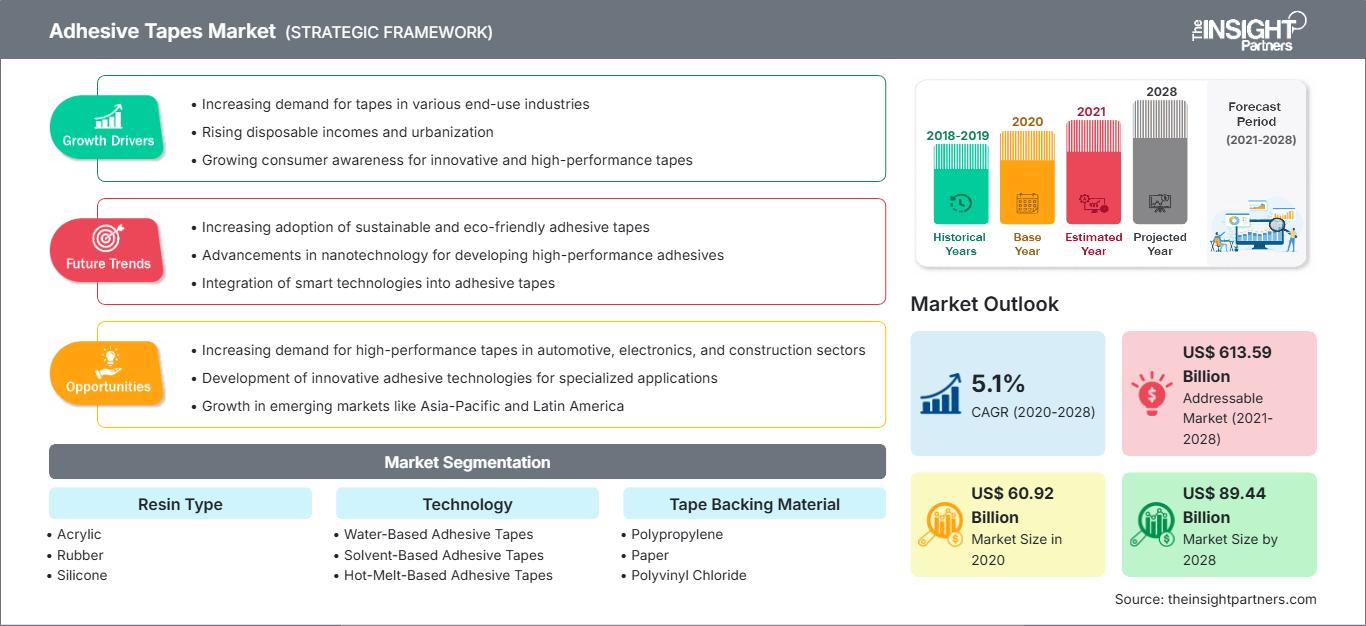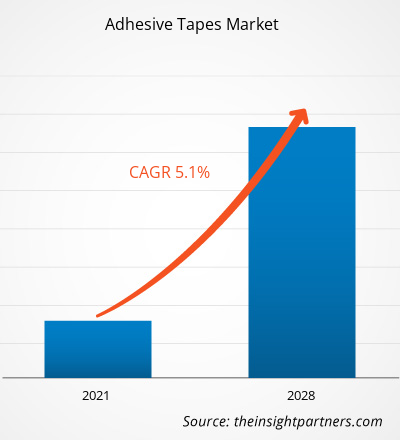Der Markt für Klebebänder wurde im Jahr 2020 auf 60.922,61 Millionen US-Dollar geschätzt und soll bis 2028 89.440,92 Millionen US-Dollar erreichen; von 2021 bis 2028 wird ein CAGR-Wachstum von 5,1 % erwartet.
Klebebänder gibt es in zwei Arten:
Spezialbänder und Standardbänder. Die für Klebebänder verwendeten Beschichtungstechnologien sind wasserbasiert, lösungsmittelbasiert und Hotmelt. Technologische Fortschritte haben in der jüngeren Vergangenheit zu einer
steigenden Nachfrage nach leichten Trägermaterialien geführt. Klebebänder bieten ein breites Anwendungsspektrum in der Verpackungs-, Automobil- und Gesundheitsbranche.
Im Jahr 2020 hatte der asiatisch-pazifische Raum den größten Anteil am globalen Klebebandmarkt. Es wird auch erwartet, dass dieser Raum im Prognosezeitraum die höchste CAGR des Marktes verzeichnet. Die Nachfrage nach Klebebändern dürfte in der Region aufgrund verschiedener Faktoren wie der enormen Bevölkerungszahl, steigendem verfügbaren Einkommen und einem verbesserten Lebensstandard steigen. Das Wachstum des Automobilmarktes hat die Nachfrage nach Klebebändern im asiatisch-pazifischen Raum zusätzlich angekurbelt. Diese Faktoren haben auch ausländische Unternehmen dazu bewogen, ihre Geschäfte in der Region auszuweiten. Das schnelle Wachstum im asiatisch-pazifischen Raum ist zudem auf das Wachstum der Bauindustrie in der Region zurückzuführen. China ist der weltweit größte Baumarkt und dürfte in den nächsten Jahren deutlich wachsen. Auch andere Volkswirtschaften, wie Indien, werden voraussichtlich stark wachsen, wobei der Schwerpunkt auf der Förderung der inländischen Produktion liegt.
Die Auswirkungen der COVID-19-Pandemie auf den globalen Klebebandmarkt sind gemischt. Verschiedene Branchen wie die Automobil-, Bau-, Elektronik- und Elektroindustrie verzeichneten starke Rückgänge. Demgegenüber verzeichnete die Gesundheitsbranche seit dem Ausbruch aufgrund der übermäßigen Nachfrage nach persönlicher Schutzausrüstung und medizinischer Ausrüstung ein Wachstum. Angesichts der wirtschaftlichen Erholung planen mehrere Branchen und Volkswirtschaften strategische Investitionen im Gesundheitssektor. Dies dürfte dem Wachstum des Klebebandmarktes neue Impulse verleihen. Gesundheitsbezogene Initiativen umfassen den Kauf professioneller medizinischer und persönlicher Schutzausrüstung (PSA), den Ausbau der Forschungskapazitäten, die Einstellung zusätzlichen Personals und zusätzlicher Sozialleistungen, die Unterstützung von Krankenhäusern und Kommunalverwaltungen sowie die Spende von Impfstoffen. Darüber hinaus haben viele Unternehmen wie 3M Company, Tesa SE und Nitto Denko Corporation begonnen, das Produkt aktiv zu vermarkten, um ihren Kundenstamm zu erweitern und die Auswirkungen auf das Geschäft zu reduzieren.
Passen Sie diesen Bericht Ihren Anforderungen an
Sie erhalten kostenlos Anpassungen an jedem Bericht, einschließlich Teilen dieses Berichts oder einer Analyse auf Länderebene, eines Excel-Datenpakets sowie tolle Angebote und Rabatte für Start-ups und Universitäten.
Markt für Klebebänder: Strategische Einblicke

- Holen Sie sich die wichtigsten Markttrends aus diesem Bericht.Dieses KOSTENLOSE Beispiel umfasst Datenanalysen, die von Markttrends bis hin zu Schätzungen und Prognosen reichen.
Markteinblicke: Breites Anwendungsspektrum von Klebebändern
Sie erhalten kostenlos Anpassungen an jedem Bericht, einschließlich Teilen dieses Berichts oder einer Analyse auf Länderebene, eines Excel-Datenpakets sowie tolle Angebote und Rabatte für Start-ups und Universitäten.
Markt für Klebebänder: Strategische Einblicke

- Holen Sie sich die wichtigsten Markttrends aus diesem Bericht.Dieses KOSTENLOSE Beispiel umfasst Datenanalysen, die von Markttrends bis hin zu Schätzungen und Prognosen reichen.
Klebebänder sind Material- und Klebefilmkombinationen, die zum Verkleben oder Verbinden von Objekten verwendet werden, anstatt Schrauben, Befestigungselemente oder Schweißnähte zu verwenden. Das Band kann die Oberfläche schützen, da keine Befestigungselemente oder Schrauben zum Schutz der Oberfläche erforderlich sind, und ist daher für verschiedene Anwendungen in Branchen wie Verpackung, Gesundheitswesen, Automobilindustrie, Elektrik und Elektronik sowie Bauwesen nützlich. Flüssige Klebstoffe sind schmutzig und zeitaufwändig, da sie vor dem Verkleben auf die Oberfläche gesprüht oder gerollt werden müssen. Klebebänder finden wichtige Anwendungen in Branchen wie Verpackung, Gesundheitswesen, Automobilindustrie, Elektrik und Elektronik sowie Bauwesen.
Anwendungseinblicke
Basierend auf der Anwendung ist der globale Markt für Klebebänder in Verpackung, Gesundheitswesen, Automobilindustrie, Elektrik und Elektronik, Bauwesen und Sonstige segmentiert. Das Segment Automobilindustrie war 2020 marktführend. Klebebänder finden im Automobilsektor vielfältige Anwendungsmöglichkeiten. Im Fahrzeuginnenraum werden Klebebänder für Sitzheizungselemente, Airbag-Ummantelungen und -Sicherung, Lenkradummantelungen, Gummilager, Kunststoffprofile sowie Schaumstoff- und Stoffbefestigungen an der Instrumententafel verwendet. In Fahrzeuginnenräumen mit Funktionen wie Halterungen für Mobilgeräte, elektronischen Ladegeräten, Luftreinigern, Anschlüssen für tragbare Gefrierschränke und anderen Komponenten werden Klebebänder zum Befestigen und Verbinden eingesetzt. Darüber hinaus werden sie zur Entwicklung von Fahrzeugelektronik verwendet, beispielsweise für Leuchtenbaugruppen, Klimaanlagen, elektronische Anzeigetafeln, Batterieanschlüsse und -kabel sowie Sensoren. Klebebänder ersetzen zunehmend Schrauben- und Mutternbefestigungen, um das Fahrzeuggewicht zu reduzieren und die Fahrzeugästhetik zu verbessern. Die steigende Nachfrage nach leichten Dichtungen in Fahrzeugen und die zunehmende Verwendung von Klebebändern bei der Herstellung von Elektrofahrzeugen werden das Wachstum des Klebebandmarktes in den kommenden Jahren voraussichtlich ankurbeln.
Einige wichtige Marktteilnehmer auf dem Klebebandmarkt sind 3M, Nitto Denko Corporation, tesa SE, Avery Dennison Corporation, Intertape Polymer Group, LINTEC Corporation, Berry Global Inc, Scapa, Lohmann GmbH & Co.KG und Rogers Corporation.
Berichts-Spotlights
- Fortschreitende Branchentrends auf dem globalen Markt für Klebebänder, um Akteuren bei der Entwicklung effektiver langfristiger Strategien zu helfen
- Geschäftswachstumsstrategien in entwickelten und sich entwickelnden Märkten
- Quantitative Analyse des globalen Marktes für Klebebänder von 2019 bis 2028
- Schätzung der Nachfrage nach Klebebändern in verschiedenen Branchen
- PEST-Analyse zur Veranschaulichung der Wirksamkeit von in der Branche tätigen Käufern und Lieferanten zur Vorhersage des Marktwachstums
- Jüngste Entwicklungen zum Verständnis des Wettbewerbsmarktszenarios und der Nachfrage nach Klebebändern
- Markttrends und -aussichten sowie Faktoren, die das Wachstum des Marktes für Klebebänder fördern und hemmen
- Entscheidungsprozess durch das Verständnis von Strategien, die das kommerzielle Interesse im Hinblick auf das Wachstum des globalen Marktes für Klebebänder untermauern
- Marktgröße für Klebebänder an verschiedenen Marktknotenpunkten
- Detaillierte Übersicht und Segmentierung des globalen Marktes für Klebebänder sowie seine Dynamik in der Branche
- Marktgröße für Klebebänder in verschiedenen Regionen mit vielversprechenden Wachstumschancen
Der Bericht segmentiert den globalen Markt für Klebebänder wie folgt:
- Nach Harztyp ist der Markt für Klebebänder in Acryl, Gummi, Silikon und Sonstige unterteilt.
- Nach Technologie ist der Markt für Klebebänder in wasserbasierte Klebebänder, lösungsmittelbasierte Klebebänder und Heißklebebänder unterteilt.
- Nach Bandträgermaterial ist der Markt für Klebebänder in Polypropylen (PP), Papier, Polyvinylchlorid (PVC) und Sonstige unterteilt.
- Nach Anwendung ist der Markt für Klebebänder in Verpackung, Gesundheitswesen, Automobil, Elektrik und Elektronik, Bauwesen und Konstruktion sowie Sonstige unterteilt.
Markt für Klebebänder
Die Analysten von The Insight Partners haben die regionalen Trends und Faktoren, die den Markt für Klebebänder im Prognosezeitraum beeinflussen, ausführlich erläutert. In diesem Abschnitt werden auch die Marktsegmente und die geografische Lage in Nordamerika, Europa, dem asiatisch-pazifischen Raum, dem Nahen Osten und Afrika sowie Süd- und Mittelamerika erörtert.Umfang des Marktberichts zu Klebebändern
| Berichtsattribut | Einzelheiten |
|---|---|
| Marktgröße in 2020 | US$ 60.92 Billion |
| Marktgröße nach 2028 | US$ 89.44 Billion |
| Globale CAGR (2020 - 2028) | 5.1% |
| Historische Daten | 2018-2019 |
| Prognosezeitraum | 2021-2028 |
| Abgedeckte Segmente |
By Harztyp
|
| Abgedeckte Regionen und Länder | Nordamerika
|
| Marktführer und wichtige Unternehmensprofile |
|
Dichte der Marktteilnehmer für Klebebänder: Verständnis ihrer Auswirkungen auf die Geschäftsdynamik
Der Markt für Klebebänder wächst rasant. Die steigende Nachfrage der Endverbraucher ist auf Faktoren wie veränderte Verbraucherpräferenzen, technologische Fortschritte und ein stärkeres Bewusstsein für die Produktvorteile zurückzuführen. Mit der steigenden Nachfrage erweitern Unternehmen ihr Angebot, entwickeln Innovationen, um den Bedürfnissen der Verbraucher gerecht zu werden, und nutzen neue Trends, was das Marktwachstum weiter ankurbelt.

- Holen Sie sich die Markt für Klebebänder Übersicht der wichtigsten Akteure
- 3M
- Nitto Denko Corporation
- tesa SE
- Avery Dennison Corporation
- Intertape Polymer Group
- LINTEC Corporation
- Berry Global Inc
- Scapa
- Lohmann GmbH & Co.KG
- Rogers Corporation
- Historische Analyse (2 Jahre), Basisjahr, Prognose (7 Jahre) mit CAGR
- PEST- und SWOT-Analyse
- Marktgröße Wert/Volumen – Global, Regional, Land
- Branchen- und Wettbewerbslandschaft
- Excel-Datensatz
Aktuelle Berichte
Verwandte Berichte
Erfahrungsberichte
Grund zum Kauf
- Fundierte Entscheidungsfindung
- Marktdynamik verstehen
- Wettbewerbsanalyse
- Kundeneinblicke
- Marktprognosen
- Risikominimierung
- Strategische Planung
- Investitionsbegründung
- Identifizierung neuer Märkte
- Verbesserung von Marketingstrategien
- Steigerung der Betriebseffizienz
- Anpassung an regulatorische Trends




















 Kostenlose Probe anfordern für - Markt für Klebebänder
Kostenlose Probe anfordern für - Markt für Klebebänder